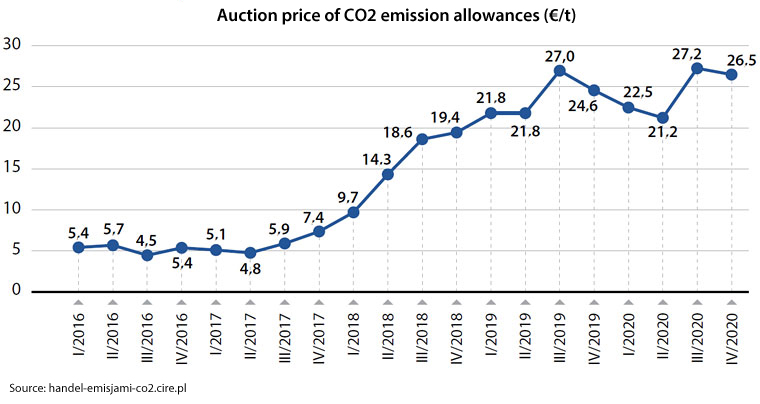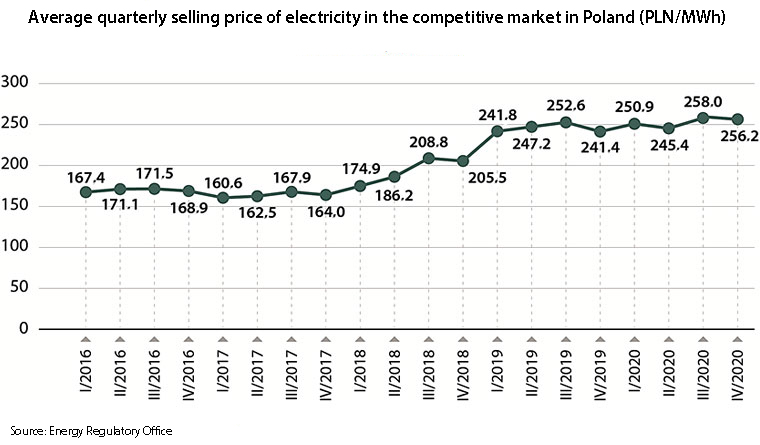Electricity prices in Poland are driven by black and brown coal prices as well as CO2 emission allowance prices.
Entities using plants which emit carbon dioxide, including power plants and power and heat plants producing electricity from carbon and gas, need to buy CO2 emission allowances. Until 2018, the allowance prices were not high due to their high supply. However, in April 2018 the European Parliament directive came into force, changing the system of trade in allowances. This has led to a sharp increase in allowance prices and consequentially energy prices in the wholesale market started to rise immediately. In the first quarter 2017, one megawatt-hour cost PLN 160.6, whereas in the first quarter 2020 it was as much as PLN 250.9. Trends in the wholesale market forced energy companies to prepare new price lists and even 50% higher tariffs than in 2018.
In November 2018, the government announced that electricity prices in 2019 would not increase because electric energy users need to be protected from a sudden rise in electricity costs. In December 2018, the Sejm passed the so-called Electricity Act which came into force on 1 January 2019.
The following solutions were implemented:
- excise tax was reduced from PLN 20/MWh to PLN 5/MWh,
- transitory energy prices were cut,
- mechanism for maintaining electricity prices from the first half of 2018 to the end of 2019 was introduced, assuming simultaneous disbursement of lost revenues to trading companies.
Key audit findings
A strategic document on power industry is the Energy Policy of Poland, adopted by the government in 2009. The next document should be developed within 4 years. The following Energy Policy of Poland 2040 was adopted on 2 February 2021, after the end of the NIK audit.
In public offices of the Ministry of Energy there were units responsible for developing system solutions and conducting system analyses of the electricity market.
In the opinion of NIK the absence of regular analyses of the energy market in 2016-2020 was unreliable. According to NIK, the legislative works on the Electricity Act could have been started too late due to the absence of systematic monitoring of the electricity market developments.
At the same time, in the second half of the 21st century, the European Union consistently sought the reduction of greenhouse emissions. In 2015, the European Parliament adopted the directive reducing the supply of CO2 emission allowances (it entered into force in 2018). As a result, their prices went up which led to an increase in prices of electric energy made of fossil fuels.

The Minister of Energy received a lot of signals about increasing prices of energy, among others from the President of the Energy Regulatory Office (ERO). He communicated that four official energy providers demanded an energy price increase from 30% to 35%.

In the face of sudden rises in energy prices and the 2019 forecasts, in September 2018 the Minister of Energy started to work on a law to protect domestic energy users from fee increases in 2019. However, neither the draft act, nor its amendment were submitted for inter-ministerial or public consultations. Neither of those documents was advised by competent bodies. The law impact evaluation, enclosed with the draft act did not include information on the sources of data based on which it was developed or the sources of financing proposed changes. Also, the evaluation did not include any analysis of possible consequences for the electric energy sector, including revenue loss or import increase. NIK has pointed out that none of the trading companies participated in any form of works on the initial draft of the act.
The Sejm adopted the Act in December 2018. Since then it has been amended four times. According to NIK it shows that the first draft and subsequent amendments were improperly developed. It also reveals that the principle of stability and reliability of legal provisions for entities governed by those provisions was not complied with.
Works on the ordinance on energy prices started only after the act came into force (six months later). In line with applicable law, though, it should come into effect together with the Act under which it is issued.
The level of energy prices in the wholesale and retail markets was monitored on an ongoing basis by the President of ERO. At the end of 2018, a spike in electricity prices was reported.
Suspecting illegal practices, the President conducted two explanatory proceedings. As a result, two reports of possible criminal activity related to manipulations in the market were filed with the Prosecutor’s Office which started an investigation. ERO President also took actions after persons operating in the energy market submitted their reports. In 2016-2020, ERO President received nine reports of possible price manipulations from persons involved in professional energy trading. Having analysed the situation, the President of ERO sent three reports to the Prosecutor’s Office which received 21 signals from other entities. Part of them also ended in reports of possible criminal activity.
Payment of compensations and price differences was handled by the Energy Settlement Operator (ESO). The money came from the Price Difference Payment Fund. According to NIK, ESO properly planned compensation amounts related to electricity price freeze in 2019 for end users and payments for energy companies. The Energy Settlement Operator adequately accepted and verified applications for benefits for electricity trading companies. Information on subsidies, price differences and financial compensation were available for applicants and were provided in a clear way, leaving no place for doubt. The energy trading companies audited by NIK applied adequate prices to energy users, however they had some delays in obligatory change of contractual and re-invoicing terms.
Implementation and performance of the Electricity Act was related to high costs for the Energy Settlement Operator and trading companies, e.g. for:
- employment and training of new employees, payment of overtime work compensation and employee benefits;
- purchase of new software or its upgrade;
- design, printout and dispatch of information materials for clients and additional invoices;
- legal service, including development of legal opinions concerning interpretation and application of provisions of the Electricity Act and the relevant ordinance.
The costs of implementing the new law totalled nearly PLN 24 million. At the same time, financial costs incurred by three trading companies reached almost PLN 47 million. The cost of payments from the Price Difference Payment Fund amounted to PLN 4.5 billion.
Savings of energy users from different tariff groups in individual companies were estimated based on prices applied to energy users in 2019 and the highest prices recommended in tariff applications for 2019. In the most popular tariff “G”, used by households, average annual savings ranged from PLN 109 to PLN 305 per household. The largest amount saved by a user applying tariff G was PLN 127 thousand.
Among entities using tariffs not approved by ERO President the maximum savings were estimated at:
- micro-entrepreneurs or small entrepreneurs: from PLN 1.4 thousand (tariff group C) to PLN 591.7 thousand (tariff group A) and PLN 837 thousand (tariff group B),
- hospitals: from PLN 421.5 thousand to PLN 1727.9 thousand (tariff groups B and C),
- public finance units: from PLN 37.6 thousand to PLN 228.6 thousand (tariff group C).
After the Electricity Act expired, that is after 1 January 2020, the prices of electricity for tariffs (tariff G) went up by nearly 20%.

Recommendations
After the end of the audit, on 2 February 2020, the Council of Ministers adopted the Energy Policy of Poland 2040. Therefore, NIK has not referred to the adopted solutions on stabilisation of energy prices, including a drop in its production costs. NIK stands in a position that consistent provision of conditions to reduce energy production from high-emission sources will allow stabilisation of prices upon ensuring safety of electric energy deliveries.
To the Minister of Climate and Environment to:
- exercise due diligence in developing normative acts and include provisions set out in Rules on Legal Drafting and the Work Terms and Conditions of the Council of Ministers,
- properly develop legislative solutions including consultations (in a broad sense) with significant stakeholders and verification of draft provisions in line with the EU law,
- effectively monitor market processes in the area of electricity pricing and make it one of tasks of the relevant department.
To the President of Energy Regulatory Office – to introduce organisational changes and procedures enabling quick completion and on-going conduct of analyses to identify abuses and manipulations in the wholesale energy market.


